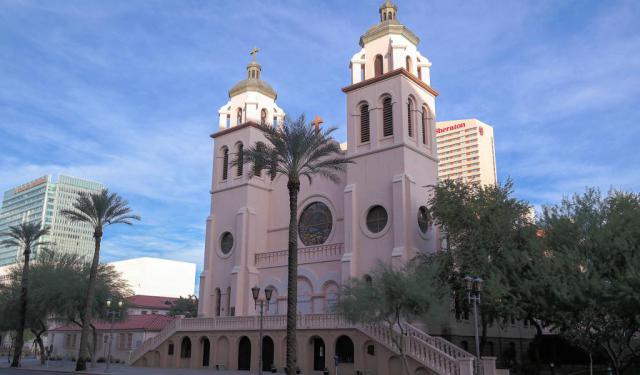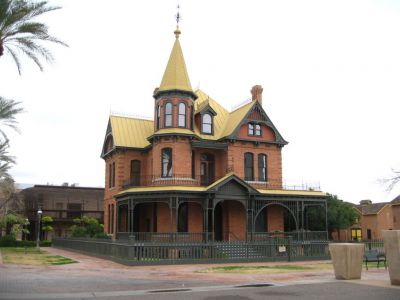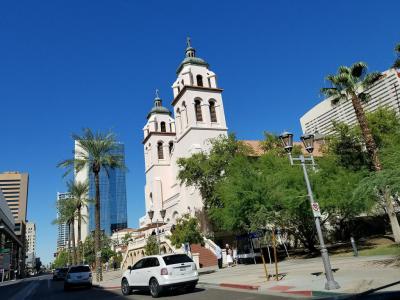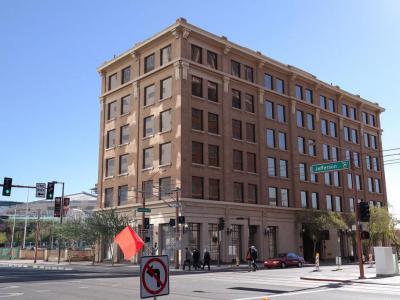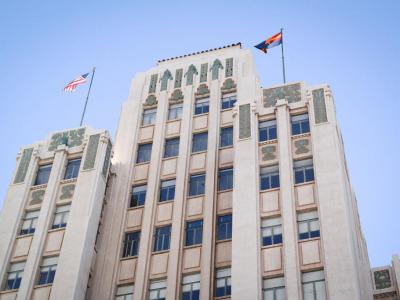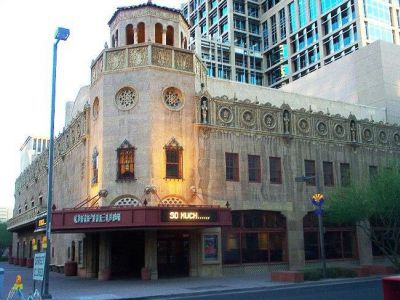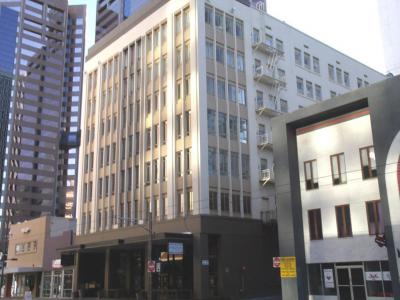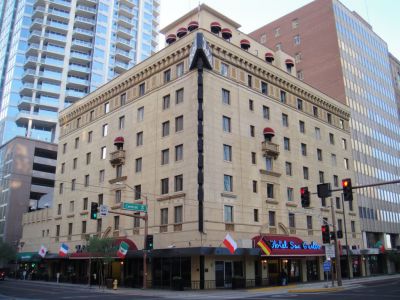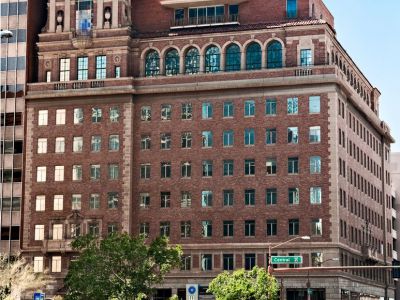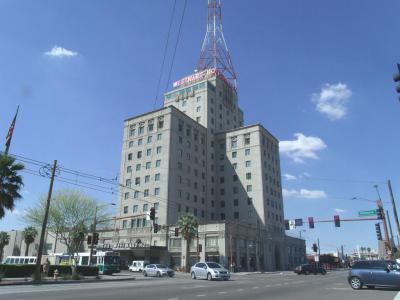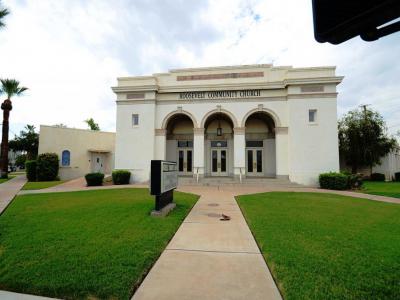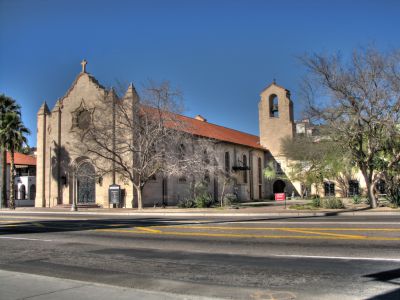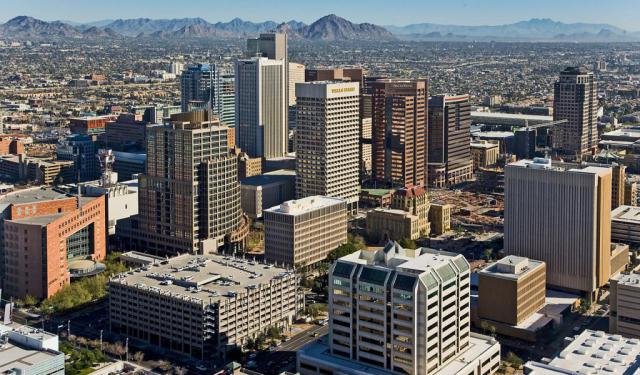Downtown Historical Landmarks Walking Tour (Self Guided), Phoenix
The downtown area of Phoenix, Arizona, is loaded with notable sites, each bearing witness to a unique chapter in the city's past, from the Victorian elegance of the Rosson House Museum to the spiritual grandeur of Saint Mary's Basilica and the cinematic allure of the Barrister Building.
The latter, known as "The Psycho" Building, gained fame for its cameo in Alfred Hitchcock's classic horror film "Psycho" which earned the city notoriety and presented Downtown Phoenix to millions of movie viewers worldwide in 1960.
Other architectural landmarks, one way or another associated with the movie, include the Luhrs Tower, an Art Deco gem; the prominent Heard Building, a testament to Phoenix's early 20th-century prosperity; and the vintage Hotel San Carlos, which over the years has welcomed countless guests, including Hollywood stars, since 1928.
Equally impressive as a living testimonial to Phoenix's evolution is the Orpheum Theater, an opulent venue completed in 1929, symbolizing the city's aspirations and growth during the Roaring Twenties.
Its coevals, the Security Building skyscraper from 1928, once the tallest in Arizona, and the iconic Westward Ho hotel also played a pivotal role in Phoenix's history and remain cherished landmarks.
Roosevelt Community Church and Trinity Cathedral, both serving the community for over a century, stand as a testament to the importance of faith in Phoenix's life.
As regards Ellis-Shackelford House, dating back to the late 19th century, this historic residence showcases the architectural styles of Phoenix's early days.
Together, these architectural marvels provide a window into the past through which one can appreciate the city's journey, hear its stories, and learn of the legacies of the people who shaped Phoenix the way it is now. Your Downtown Phoenix adventure promises to be captivating! Enjoy it, snap some photos, and gain a deeper appreciation for this bustling desert metropolis's roots.
The latter, known as "The Psycho" Building, gained fame for its cameo in Alfred Hitchcock's classic horror film "Psycho" which earned the city notoriety and presented Downtown Phoenix to millions of movie viewers worldwide in 1960.
Other architectural landmarks, one way or another associated with the movie, include the Luhrs Tower, an Art Deco gem; the prominent Heard Building, a testament to Phoenix's early 20th-century prosperity; and the vintage Hotel San Carlos, which over the years has welcomed countless guests, including Hollywood stars, since 1928.
Equally impressive as a living testimonial to Phoenix's evolution is the Orpheum Theater, an opulent venue completed in 1929, symbolizing the city's aspirations and growth during the Roaring Twenties.
Its coevals, the Security Building skyscraper from 1928, once the tallest in Arizona, and the iconic Westward Ho hotel also played a pivotal role in Phoenix's history and remain cherished landmarks.
Roosevelt Community Church and Trinity Cathedral, both serving the community for over a century, stand as a testament to the importance of faith in Phoenix's life.
As regards Ellis-Shackelford House, dating back to the late 19th century, this historic residence showcases the architectural styles of Phoenix's early days.
Together, these architectural marvels provide a window into the past through which one can appreciate the city's journey, hear its stories, and learn of the legacies of the people who shaped Phoenix the way it is now. Your Downtown Phoenix adventure promises to be captivating! Enjoy it, snap some photos, and gain a deeper appreciation for this bustling desert metropolis's roots.
How it works: Download the app "GPSmyCity: Walks in 1K+ Cities" from Apple App Store or Google Play Store to your mobile phone or tablet. The app turns your mobile device into a personal tour guide and its built-in GPS navigation functions guide you from one tour stop to next. The app works offline, so no data plan is needed when traveling abroad.
Downtown Historical Landmarks Walking Tour Map
Guide Name: Downtown Historical Landmarks Walking Tour
Guide Location: USA » Phoenix (See other walking tours in Phoenix)
Guide Type: Self-guided Walking Tour (Sightseeing)
# of Attractions: 12
Tour Duration: 2 Hour(s)
Travel Distance: 3.9 Km or 2.4 Miles
Author: Cathy
Sight(s) Featured in This Guide:
Guide Location: USA » Phoenix (See other walking tours in Phoenix)
Guide Type: Self-guided Walking Tour (Sightseeing)
# of Attractions: 12
Tour Duration: 2 Hour(s)
Travel Distance: 3.9 Km or 2.4 Miles
Author: Cathy
Sight(s) Featured in This Guide:
- Rosson House Museum
- Saint Mary's Basilica
- Barrister Building (The "Psycho" Building)
- Luhrs Tower
- Orpheum Theater
- Heard Building
- Hotel San Carlos
- Security Building
- Westward Ho
- Roosevelt Community Church
- Trinity Cathedral
- Ellis-Shackelford House
1) Rosson House Museum (must see)
The Rosson House Museum is a beautiful example of Eastlake Victorian architecture. The house was built in 1895 for Dr. Rosson and his wife. This interesting house has a moon gate that gives it an oriental flavor, and a tower in the shape of an octagon that is usually attributed to French design. The home is built from locally produced red brick and wood. Although not the first home to be built of fired brick rather than adobe, it is still a great example of early workmanship.
This house had all the modern conveniences that included electric lights, indoor plumbing for both hot and cold water and upstairs bathroom facilities. There were gas appliances and telephone service. Today, this house has been lovingly restored to its former glory and docent guided tours will give a real feel for how life was at the turn of the 20th century for Dr. and Mrs. Rosson.
The home is located in the Historic Heritage Square District. Tickets for the docent lead tours can be purchased next door at the Emporium. Tours are conducted Wednesday through Saturday from 10am to 5pm and Sundays from noon to 5pm.
This house had all the modern conveniences that included electric lights, indoor plumbing for both hot and cold water and upstairs bathroom facilities. There were gas appliances and telephone service. Today, this house has been lovingly restored to its former glory and docent guided tours will give a real feel for how life was at the turn of the 20th century for Dr. and Mrs. Rosson.
The home is located in the Historic Heritage Square District. Tickets for the docent lead tours can be purchased next door at the Emporium. Tours are conducted Wednesday through Saturday from 10am to 5pm and Sundays from noon to 5pm.
2) Saint Mary's Basilica (must see)
Saint Mary’s Basilica is a historical church in the downtown Phoenix area. The church was founded in 1881 and staffed by the Franciscan Friars since 1895. It is the oldest Roman Catholic parish church in the greater Phoenix area.
The construction of the church building started in 1902, but was not completed until 1914. It was placed on the National Register of Historic Places in 1978, just in time for their 100th anniversary.
From an architectural perspective, you will want to check out the wonderful stained glass windows in the church. The Carillon Tower is also beautiful, and accentuates the Spanish architecture of the building. The building was honored in 1985 as a minor basilica. The location really became famous, though, when Pope John Paul II visited this place in 1987.
The church is open to the public Monday through Friday from 10:00 a.m. until 2:00 p.m. Mass is at noon and 5:00 p.m. on those days. There is a vigil on Saturdays at 9:00 a.m. and mass again on Sundays at 11:00 a.m. The building typically opens one hour before mass on the weekends.
The construction of the church building started in 1902, but was not completed until 1914. It was placed on the National Register of Historic Places in 1978, just in time for their 100th anniversary.
From an architectural perspective, you will want to check out the wonderful stained glass windows in the church. The Carillon Tower is also beautiful, and accentuates the Spanish architecture of the building. The building was honored in 1985 as a minor basilica. The location really became famous, though, when Pope John Paul II visited this place in 1987.
The church is open to the public Monday through Friday from 10:00 a.m. until 2:00 p.m. Mass is at noon and 5:00 p.m. on those days. There is a vigil on Saturdays at 9:00 a.m. and mass again on Sundays at 11:00 a.m. The building typically opens one hour before mass on the weekends.
3) Barrister Building (The "Psycho" Building)
The Barrister Building was built in 1915 as the Jefferson Hotel. When it was built, it was the tallest building in the state. It was celebrated for its rooftop garden and modern features.
The building's claim to fame is its brief cameo in the 1960 Alfred Hitchcock film Psycho. The film was set in Phoenix, and the building was used during the opening sequence.
The city owned the building from 1990 onward, and it sat vacant most of the time. In 2016, the city sold the building to a private developer. The high-rise is now home to high-end condominiums, some of which cost more than $1 million. There are also shops and restaurants. The building, now called Jefferson Place, has been preserved and still appears much as it did in its earlier years. Eventually, the project is set to expand with new high rises in the area, but none of them will shadow the original Barrister Building.
The building's claim to fame is its brief cameo in the 1960 Alfred Hitchcock film Psycho. The film was set in Phoenix, and the building was used during the opening sequence.
The city owned the building from 1990 onward, and it sat vacant most of the time. In 2016, the city sold the building to a private developer. The high-rise is now home to high-end condominiums, some of which cost more than $1 million. There are also shops and restaurants. The building, now called Jefferson Place, has been preserved and still appears much as it did in its earlier years. Eventually, the project is set to expand with new high rises in the area, but none of them will shadow the original Barrister Building.
4) Luhrs Tower
Luhrs Tower is a historical skyscraper located in downtown Phoenix. It is located at the intersection of First Avenue and Jefferson Street, just south of Patriots Square Park.
It was built in 1929 by George Luhrs, who was a successful businessman in Phoenix at the time. The tower rises a whopping 185 feet into the skyline of the downtown area. It contains 14 stories, with matching setbacks located in the 8th and 11th floors.
Luhrs Tower, from an architectural standpoint, is a fine example of art deco. The building was designed by Trost & Trost of El Paso, Texas, who also designed the local landmark O.T. Bassett Tower in their hometown. It is not surprising that the two buildings share many architectural features.
The building gained wide attention when it appeared in the background of a scene from the 1960 Alfred Hitchcock film Psycho. In the movie, the character Marion Crane crossed the street here to make a deposit for her boss.
It was built in 1929 by George Luhrs, who was a successful businessman in Phoenix at the time. The tower rises a whopping 185 feet into the skyline of the downtown area. It contains 14 stories, with matching setbacks located in the 8th and 11th floors.
Luhrs Tower, from an architectural standpoint, is a fine example of art deco. The building was designed by Trost & Trost of El Paso, Texas, who also designed the local landmark O.T. Bassett Tower in their hometown. It is not surprising that the two buildings share many architectural features.
The building gained wide attention when it appeared in the background of a scene from the 1960 Alfred Hitchcock film Psycho. In the movie, the character Marion Crane crossed the street here to make a deposit for her boss.
5) Orpheum Theater
The Orpheum Circuit was a chain of theaters around the country that hosted movies and vaudeville shows. It was begun in 1886 and continued until 1927 when it became part of Radio Keith Orpheum (RKO) corporation.
The Phoenix theater was built from 1927 to 1929. It's a 1,364-seat theater built in the Spanish Revival style, with Spanish Baroque architecture. Like many themed 1920s theaters, the Orpheum was designed to provide an immersive experience for theatergoers. The murals and moldings inside the building are designed to make theatergoers feel like they're watching the shows outdoors.
The theater was owned by a host of various chains over the years, including Paramount and Nederlander, who showed Broadway productions there and called it the Palace West. During the 70s and 80s, a local company used it for Hispanic events and movies. It was purchased by the city in 1984 and fully restored at the cost of $14 million. It reopened in 1997 as the Orpheum. It hosts Broadway musicals, concerts, and other special events. It is also the home to the Phoenix Opera. In 2020, special film screenings began showing throughout the year, adding movies to the list of noteworthy events you can still see in this beautiful facility.
Since 1985, it has been listed on the National Register of Historic Places. Visiting the lavishly appointed theater from the golden era of film and vaudeville is a real treat. The facility has been meticulously maintained to appear as it did when it first opened.
The Phoenix theater was built from 1927 to 1929. It's a 1,364-seat theater built in the Spanish Revival style, with Spanish Baroque architecture. Like many themed 1920s theaters, the Orpheum was designed to provide an immersive experience for theatergoers. The murals and moldings inside the building are designed to make theatergoers feel like they're watching the shows outdoors.
The theater was owned by a host of various chains over the years, including Paramount and Nederlander, who showed Broadway productions there and called it the Palace West. During the 70s and 80s, a local company used it for Hispanic events and movies. It was purchased by the city in 1984 and fully restored at the cost of $14 million. It reopened in 1997 as the Orpheum. It hosts Broadway musicals, concerts, and other special events. It is also the home to the Phoenix Opera. In 2020, special film screenings began showing throughout the year, adding movies to the list of noteworthy events you can still see in this beautiful facility.
Since 1985, it has been listed on the National Register of Historic Places. Visiting the lavishly appointed theater from the golden era of film and vaudeville is a real treat. The facility has been meticulously maintained to appear as it did when it first opened.
6) Heard Building
The Heard Building is another historical building in Phoenix downtown and a local icon. It is a 7-story high-rise building in Phoenix; it housed the offices of The Arizona Republic (formerly the Arizona Republican) and the Phoenix Gazette from 1920 to 1948. The building was constructed between 1919 and 1920 and was the first high-rise building to be erected in Phoenix. It held the title of tallest building in Arizona for four years until the completion of the Luhrs Building in 1924.
Construction of the building began in September 1919, and was financed by Dwight B. Heard and the Commonwealth Investment Company as a new home for his investment and publishing ventures. The building was designed by Llewellyn Adelbert Parker, who also designed several other structures in the Phoenix area including the Central Avenue Bridge, the Goodrich Building, and the Goldberg Building.
The building can be seen in the opening sequence of the 1960 Alfred Hitchcock film Psycho. The clip fades in centered on Hotel San Carlos. You can see the former Arizona Bank Building under-construction just west of Hotel San Carlos. Camelback Mountain can be seen in the background. When the camera pans to the right you can see the Heard Building in the foreground with its antenna.
Construction of the building began in September 1919, and was financed by Dwight B. Heard and the Commonwealth Investment Company as a new home for his investment and publishing ventures. The building was designed by Llewellyn Adelbert Parker, who also designed several other structures in the Phoenix area including the Central Avenue Bridge, the Goodrich Building, and the Goldberg Building.
The building can be seen in the opening sequence of the 1960 Alfred Hitchcock film Psycho. The clip fades in centered on Hotel San Carlos. You can see the former Arizona Bank Building under-construction just west of Hotel San Carlos. Camelback Mountain can be seen in the background. When the camera pans to the right you can see the Heard Building in the foreground with its antenna.
Sight description based on Wikipedia.
7) Hotel San Carlos
The San Carlos Hotel is a historical place to stay in Phoenix. It is also a very popular tourist attraction in town. These grounds used to be the location for the first school in Phoenix, back in 1874. The school remained here until 1928, when preparation for the new hotel was started. It competed for years with the Westward Ho, which is also located on Central Avenue. You used to be able to see the likes of Mae West, Clark Gable, Carole Lombard, Gene Autry and Jack Dempsey here at one time or another. Marilyn Monroe also stayed here.
The hotel can be briefly seen in the opening shot of Alfred Hitchcock's 1960 film Psycho, as the camera pans the then-skyline of downtown Phoenix.
The most famous factoid about his hotel is that it is reported to be haunted. For years it has been the site of multiple ghost sightings. The most common sighting is that of Leone Jensen, who visited the hotel in 1928. She committed suicide while there.
The San Carlos was added to the National Register of Historic Places in 1983. The City of Phoenix also added it as a historic location in 2003. The Travel Channel did a show about the place in 2004, which still airs on occasion.
The hotel can be briefly seen in the opening shot of Alfred Hitchcock's 1960 film Psycho, as the camera pans the then-skyline of downtown Phoenix.
The most famous factoid about his hotel is that it is reported to be haunted. For years it has been the site of multiple ghost sightings. The most common sighting is that of Leone Jensen, who visited the hotel in 1928. She committed suicide while there.
The San Carlos was added to the National Register of Historic Places in 1983. The City of Phoenix also added it as a historic location in 2003. The Travel Channel did a show about the place in 2004, which still airs on occasion.
8) Security Building
The Security Building is a wonderful old historic location in downtown Phoenix. It also represents another triumph for the efforts of the city to make use of their historic buildings. Constructed in 1928, it is located at the intersection of Central Avenue and Van Buren Street. The easiest way to find this location is by looking for the Chase Tower, which is Arizona’s tallest building. The two places are next to one another.
In 1928, the Security Building used to be the tallest structure in the state, so it was quite impressive for its day. The place was built by the Dwight B. Heard Investment Company. Heard was one of the most successful businessmen in Arizona, owning an investment company, a cattle company, and the Arizona Republican newspaper. Originally, this was the premiere office building for produce growers and law firms in Phoenix.
If you go to visit, make sure you look for the glass oval which sits atop the brick exterior of the building. At one time, it shot a beam of light into the sky that could be seen for 30 miles away on a clear night.
The Security Building was listed on the National Register of Historic Places in 1985.
In 1928, the Security Building used to be the tallest structure in the state, so it was quite impressive for its day. The place was built by the Dwight B. Heard Investment Company. Heard was one of the most successful businessmen in Arizona, owning an investment company, a cattle company, and the Arizona Republican newspaper. Originally, this was the premiere office building for produce growers and law firms in Phoenix.
If you go to visit, make sure you look for the glass oval which sits atop the brick exterior of the building. At one time, it shot a beam of light into the sky that could be seen for 30 miles away on a clear night.
The Security Building was listed on the National Register of Historic Places in 1985.
9) Westward Ho
Westward Ho is a historical skyscraper and visitor attraction located in downtown Phoenix. It was completed in 1928, and was originally put into use as a hotel, which went by the same name. At one point in history (pre 1960) this hotel was the tallest building in the state of Arizona. It was quite impressive for its day.
The building was solely used as one of the premiere hotels in Phoenix until 1979. Two years later, the location was turned into apartment style housing for local seniors. In 2003-2004 time frames, the building went through a significant remodeling.
There is a popular urban legend that stated that this place was the original hotel used in the old movie Psycho. Actually, the Westward Ho was only used in the remake of the movie. But the building did appear in the 1956 film Bus Stop starring Marilyn Monroe. The parade scenes were filmed on Central Ave in front of the building entrance.
The building was solely used as one of the premiere hotels in Phoenix until 1979. Two years later, the location was turned into apartment style housing for local seniors. In 2003-2004 time frames, the building went through a significant remodeling.
There is a popular urban legend that stated that this place was the original hotel used in the old movie Psycho. Actually, the Westward Ho was only used in the remake of the movie. But the building did appear in the 1956 film Bus Stop starring Marilyn Monroe. The parade scenes were filmed on Central Ave in front of the building entrance.
10) Roosevelt Community Church
Roosevelt Community Church is a historic church. Established in 1893, the church has been a fixture of the local community for over a century, providing a welcoming and inclusive space for worship, fellowship, and community building.
The church's architecture is a testament to its rich history, featuring a beautiful red brick exterior, intricate stained glass windows, and a distinctive bell tower. Inside, the church is equally impressive, with a soaring nave, a beautiful pipe organ, and a warm and inviting atmosphere.
Beyond its religious services, Roosevelt Community Church is also a hub for community events and social justice activism. The church hosts a variety of community programs, including a food bank, a community garden, and a social justice ministry that advocates for the rights of marginalized communities.
Overall, Roosevelt Community Church is a beloved institution in Phoenix's downtown community, known for its welcoming spirit, rich history, and commitment to social justice. Whether you're seeking spiritual nourishment, a sense of community, or an opportunity to give back, Roosevelt Community Church offers something for everyone.
The church's architecture is a testament to its rich history, featuring a beautiful red brick exterior, intricate stained glass windows, and a distinctive bell tower. Inside, the church is equally impressive, with a soaring nave, a beautiful pipe organ, and a warm and inviting atmosphere.
Beyond its religious services, Roosevelt Community Church is also a hub for community events and social justice activism. The church hosts a variety of community programs, including a food bank, a community garden, and a social justice ministry that advocates for the rights of marginalized communities.
Overall, Roosevelt Community Church is a beloved institution in Phoenix's downtown community, known for its welcoming spirit, rich history, and commitment to social justice. Whether you're seeking spiritual nourishment, a sense of community, or an opportunity to give back, Roosevelt Community Church offers something for everyone.
11) Trinity Cathedral
The Trinity Cathedral is the home of one of the oldest Episcopal Churches in the city of Phoenix. It is located on Roosevelt Street, in the heart of the historic Roosevelt District. If was founded in 1885, well before the State of Arizona joined the Union. It was modeled in a four sided shape.
The Cathedral House was finished in 1915, and represents one side of the quadrangle. The Cathedral itself is on another. Atwood Hall, which was completed in 1931, represents a third side. The first worship services were held here in 1920, on Christmas Day. In 1988, this place became the Cathedral for the Diocese of Arizona.
The building is done in a Spanish Revival style of architecture. One of the highlights of the building is the grand Organ in the sanctuary. It is a four manual, 71 rank pipe organ, built by the Schantz Organ Company. The grand piano in the worship area was hand made by Bosendorfer of Vienna, Austria.
The Cathedral House was finished in 1915, and represents one side of the quadrangle. The Cathedral itself is on another. Atwood Hall, which was completed in 1931, represents a third side. The first worship services were held here in 1920, on Christmas Day. In 1988, this place became the Cathedral for the Diocese of Arizona.
The building is done in a Spanish Revival style of architecture. One of the highlights of the building is the grand Organ in the sanctuary. It is a four manual, 71 rank pipe organ, built by the Schantz Organ Company. The grand piano in the worship area was hand made by Bosendorfer of Vienna, Austria.
12) Ellis-Shackelford House
At one time, North Central Avenue was known as "Millionaires' Row" because of the mansions that lined it. The only surviving and unaltered mansion is the Ellis-Shackelford House, which was first built by Dr. Ellis. Ellis was the chief of the medical staff at the Arizona Deaconess Hospital, now Good Samaritan. Ellis's daughter and her husband, J. Gordon Shackelford, lived in the house until 1964. It's now owned by the city and is home to the Arizona Humanities. It's available for special events.
The house was built in 1917 by architect R.A. Gray. It has three stories plus a basement and features many beautiful touches. There are hand-painted globe chandeliers, wire-cut bricks from Colorado, and wood trim from imported Filipino mahogany. The designer used the familiar Midwest Prairie Style but with lots of Mediterranean detailing. The house features a Porte-Cochere, a covered entrance for vehicles on the southeast side. It fit the Model-Ts and carriages of the day, but later cars became too wide. The house also features an original 1917 model Night and Day Solar Water Heater and a central vacuum system.
This part of town was used to boost Phoenix's image by town planners, who used the City Beautiful movement. They focused on broad sidewalks with shade trees to contrast with crowded cities out East.
The house was built in 1917 by architect R.A. Gray. It has three stories plus a basement and features many beautiful touches. There are hand-painted globe chandeliers, wire-cut bricks from Colorado, and wood trim from imported Filipino mahogany. The designer used the familiar Midwest Prairie Style but with lots of Mediterranean detailing. The house features a Porte-Cochere, a covered entrance for vehicles on the southeast side. It fit the Model-Ts and carriages of the day, but later cars became too wide. The house also features an original 1917 model Night and Day Solar Water Heater and a central vacuum system.
This part of town was used to boost Phoenix's image by town planners, who used the City Beautiful movement. They focused on broad sidewalks with shade trees to contrast with crowded cities out East.
Walking Tours in Phoenix, Arizona
Create Your Own Walk in Phoenix
Creating your own self-guided walk in Phoenix is easy and fun. Choose the city attractions that you want to see and a walk route map will be created just for you. You can even set your hotel as the start point of the walk.
Arizona State University (ASU) Walking Tour
Founded in 1885 by the 13th Arizona Territorial Legislature, Arizona State University (ASU) is one of the largest public universities by enrollment in the United States. ASU has nearly 150,000 students attending classes across its five campuses and four regional learning centers throughout the state.
The university's main campus at Tempe Arizona, east of downtown Phoenix, is an attraction... view more
Tour Duration: 2 Hour(s)
Travel Distance: 3.6 Km or 2.2 Miles
The university's main campus at Tempe Arizona, east of downtown Phoenix, is an attraction... view more
Tour Duration: 2 Hour(s)
Travel Distance: 3.6 Km or 2.2 Miles
Phoenix Introduction Walking Tour
Phoenix is the largest city in Arizona and the central city in a larger metropolitan area known as the Valley of the Sun. The city was first settled as an agricultural community where the Salt and Gila Rivers met. An intricate canal system keeps this hot corner of the Sonoran Desert fertile. In the early days, the city's economy was based on the "Five Cs"-citrus, cotton, copper,... view more
Tour Duration: 2 Hour(s)
Travel Distance: 3.7 Km or 2.3 Miles
Tour Duration: 2 Hour(s)
Travel Distance: 3.7 Km or 2.3 Miles
The Most Popular Cities
/ view all
